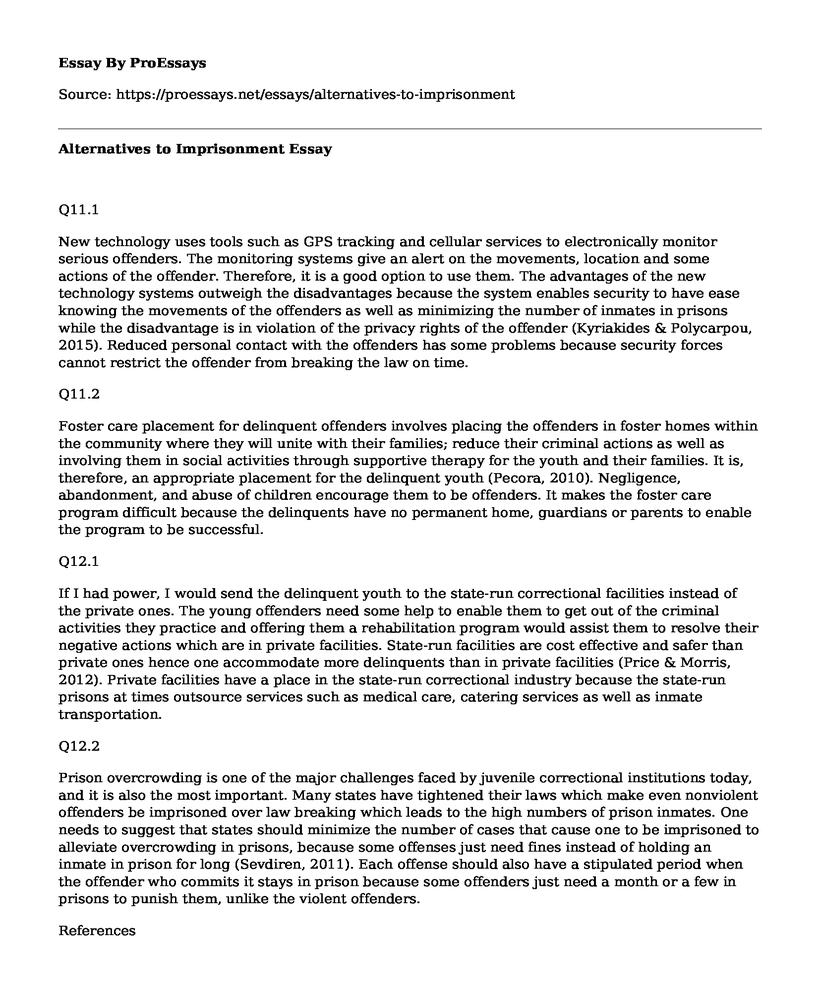Q11.1
New technology uses tools such as GPS tracking and cellular services to electronically monitor serious offenders. The monitoring systems give an alert on the movements, location and some actions of the offender. Therefore, it is a good option to use them. The advantages of the new technology systems outweigh the disadvantages because the system enables security to have ease knowing the movements of the offenders as well as minimizing the number of inmates in prisons while the disadvantage is in violation of the privacy rights of the offender (Kyriakides & Polycarpou, 2015). Reduced personal contact with the offenders has some problems because security forces cannot restrict the offender from breaking the law on time.
Q11.2
Foster care placement for delinquent offenders involves placing the offenders in foster homes within the community where they will unite with their families; reduce their criminal actions as well as involving them in social activities through supportive therapy for the youth and their families. It is, therefore, an appropriate placement for the delinquent youth (Pecora, 2010). Negligence, abandonment, and abuse of children encourage them to be offenders. It makes the foster care program difficult because the delinquents have no permanent home, guardians or parents to enable the program to be successful.
Q12.1
If I had power, I would send the delinquent youth to the state-run correctional facilities instead of the private ones. The young offenders need some help to enable them to get out of the criminal activities they practice and offering them a rehabilitation program would assist them to resolve their negative actions which are in private facilities. State-run facilities are cost effective and safer than private ones hence one accommodate more delinquents than in private facilities (Price & Morris, 2012). Private facilities have a place in the state-run correctional industry because the state-run prisons at times outsource services such as medical care, catering services as well as inmate transportation.
Q12.2
Prison overcrowding is one of the major challenges faced by juvenile correctional institutions today, and it is also the most important. Many states have tightened their laws which make even nonviolent offenders be imprisoned over law breaking which leads to the high numbers of prison inmates. One needs to suggest that states should minimize the number of cases that cause one to be imprisoned to alleviate overcrowding in prisons, because some offenses just need fines instead of holding an inmate in prison for long (Sevdiren, 2011). Each offense should also have a stipulated period when the offender who commits it stays in prison because some offenders just need a month or a few in prisons to punish them, unlike the violent offenders.
References
Kyriakides, E., & Polycarpou, M. (2015). Intelligent monitoring, control, and security of critical infrastructure systems.
Pecora, P. J. (2010). What works in foster care?: Key components of success from the Northwest Foster Care Alumni Study. Oxford: Oxford University Press.
Price, B. E., & Morris, J. C. (2012). Prison privatization: The many facets of a controversial industry. Santa Barbara, Calif: Praeger.
Sevdiren, O. (2011). Alternatives to imprisonment in England and Wales, Germany and Turkey: A comparative study. (Alternatives to Imprisonment in England and Wales, Germany and Turkey.) Berlin: Springer Berlin.
Cite this page
Alternatives to Imprisonment. (2021, Mar 11). Retrieved from https://proessays.net/essays/alternatives-to-imprisonment
If you are the original author of this essay and no longer wish to have it published on the ProEssays website, please click below to request its removal:
- Anthropology Analysis of Attitude Towards People Depending on the Profession
- Legal Challenges Towards Private Security Employees Searches in ACME Electronics Paper Example
- Criminal Behaviors: Isolation in the Community as Punishment - Essay Sample
- Essay Sample on Creating a Communication Plan: Involving Multiple Stakeholders
- Essay Example on Youth Arrests in America: 95% Non-Violent, But Records Remain
- Essay Sample on Social Class & Hidden Curriculum: Jean Anyon Examines Student Experiences
- Research Paper Example on Racial Profiling: A Discriminatory Practice







